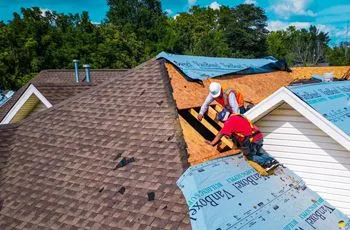What to Do After a Storm Damages Your Roof: A Homeowner’s Step-by-Step Guide
Louisville homeowners are no strangers to unpredictable weather. From heavy spring rains and high winds to summer hailstorms and winter ice, Kentucky’s changing climate can take a toll on even the most durable roofs. When a major storm hits, it’s crucial to act quickly and carefully to protect your home. This storm damage roof repair guide walks you through every step—from assessing the damage safely to filing an insurance claim and getting your roof restored.
Step 1: Prioritize Safety First
Before anything else, make sure you and your family are safe. Roof damage can lead to hazards like:
- Exposed nails or sharp debris
- Electrical issues if the wiring has been compromised
- Structural instability from fallen trees or heavy impacts
- Leaks that create slippery floors indoors
If the damage is severe, don’t climb onto the roof yourself. Instead, visually assess it from the ground or through a window. If you suspect structural issues, vacate the area until it can be professionally inspected.
This first step sets the tone for the rest of the storm damage roof repair guide—safety always comes first.
Step 2: Document the Damage Thoroughly
Once it’s safe to do so, start documenting the damage. Detailed photos and videos will be essential later when you file your insurance claim and coordinate repairs.
Tips for proper documentation:
- Take wide shots of your home’s exterior to show the overall impact.
- Zoom in on damaged shingles, flashing, gutters, or siding.
- Capture interior damage, such as water stains on ceilings or walls, which can indicate leaks.
- Include the date and time of the storm and damage in your notes or on the photo file names.
Good documentation makes the insurance claim process smoother, helping your adjuster understand the full scope of the damage.
Step 3: Prevent Further Damage with Temporary Measures
Storm damage can worsen quickly if left unattended—especially during Louisville’s rainy seasons. If you can safely access the affected area, or if a roofing professional can respond quickly, take steps to prevent further interior damage:
- Tarp the damaged section of the roof to stop additional water intrusion.
- Place buckets or containers under leaks inside the home.
- Remove valuables from affected rooms to avoid water damage.
If conditions aren’t safe, don’t attempt temporary fixes yourself. Call for emergency roof inspection and mitigation services. Many roofing companies, including American Home Exteriors, offer 24/7 emergency response after severe storms.
Step 4: Schedule a Professional Emergency Roof Inspection
Even if the damage appears minor, a professional inspection is essential. Some issues—like lifted shingles, cracked flashing, or punctured underlayment—aren’t visible from the ground. A qualified roofer can identify both obvious and hidden problems to create a full repair plan. An emergency roof inspection typically includes:
- A comprehensive evaluation of shingles, flashing, gutters, and vents
- Inspection of attic spaces for leaks or moisture
- Identifying areas where water could infiltrate over time
- Documenting findings in a report that you can provide to your insurance adjuster
Louisville homeowners should schedule this inspection as soon as possible after a storm. Prompt action can help prevent further deterioration and support your insurance claim.
Step 5: Contact Your Homeowners Insurance Company
Once you have documentation and an inspection report, contact your insurance company to start the insurance claim process. The sooner you file, the faster you can get your roof repaired or replaced.
Here’s what to expect:
- Initial claim filing: You’ll provide basic details about the storm, the type of damage, and the date it occurred.
- Insurance adjuster visit: The insurer will schedule a visit to assess the damage and determine coverage.
- Review of your roofing contractor’s report: A professional inspection report can strengthen your case and ensure nothing is overlooked.
- Claim approval or adjustments: The insurance company will outline what repairs or replacement costs are covered under your policy.
Having a trusted roofing company assist you through this step can make a big difference. They can speak directly with adjusters, explain technical details, and make sure legitimate damage is accounted for.
Step 6: Choose a Trusted Local Roofing Contractor
Not all roofing contractors are created equal, especially after a storm. Unfortunately, storm-chasing companies often flood into affected areas, promising quick fixes and low prices—but then disappear before warranty issues arise. When selecting a contractor for storm repairs in Louisville:
- Verify that licensing and insurance meet Kentucky requirements.
- Check local references and reviews to confirm their reputation.
- Ask about their experience with insurance claims and whether they can work with your adjuster.
- Get a written estimate outlining the scope of work and timeline.
American Home Exteriors is locally owned and experienced in guiding homeowners through every step of the storm damage roof repair guide, from emergency response to full restoration.

Step 7: Review Your Repair vs. Replacement Options
Depending on the extent of the storm damage, your roof may need anything from minor repairs to a full roof replacement. Your roofing contractor and insurance adjuster will help determine the most cost-effective solution.
Common scenarios:
- Minor damage: Replacing a few shingles, sealing flashing, or repairing gutters.
- Moderate damage: Larger shingle sections replaced, partial decking repairs, or extended flashing work.
- Severe damage: Full roof replacement may be necessary, especially if large sections were compromised or the roof is nearing the end of its lifespan.
If your policy covers it, roof replacement with insurance can be a smart long-term investment—especially if the storm accelerated the need for a new roof.
Step 8: Schedule Repairs or Replacement Quickly
Once the claim is approved and you’ve selected a contractor, schedule the work promptly. Louisville weather can be unpredictable, and delays could leave your home vulnerable to further damage. During this stage:
- Stay in touch with your contractor to understand the timeline and any prep needed.
- Keep communication open with your insurance company if additional issues are discovered during the repair.
- Ask about material upgrades—sometimes insurance will cover a similar product, and you can pay the difference for a higher-quality roofing material.
The goal is to restore your roof to full strength quickly and correctly.
Step 9: Keep Records of All Work Completed
For future reference and potential resale value, keep copies of all:
- Inspection reports
- Insurance claim documents
- Contractor estimates and invoices
- Photos before and after the repairs
A well-documented repair history can be useful if you sell your home or need to file future insurance claims. It also gives you peace of mind knowing your home’s exterior is protected.
Step 10: Schedule Regular Maintenance Going Forward
Once your roof is repaired or replaced, protect your investment by following regular maintenance practices. Louisville’s weather will continue to put your roof to the test, and staying proactive is key. Consider scheduling annual inspections, keeping gutters clear, and trimming nearby trees. By following a routine maintenance plan, you’ll reduce the risk of future storm-related issues and extend your roof’s lifespan.
Your Trusted Partner for Storm Damage Roof Repair
Storms can be overwhelming, but having a clear plan makes recovery manageable. This storm damage roof repair guide equips Louisville homeowners with the knowledge to act quickly, work effectively with insurance, and ensure quality repairs.
From the initial emergency roof inspection to navigating the insurance claim process and completing repairs or roof replacement with insurance, every step matters. With a trusted local partner like American Home Exteriors, you can restore your roof with confidence—and protect your home for years to come.
Need immediate help after a storm? Call American Home Exteriors today to schedule your emergency inspection and get expert support every step of the way.



